On July 23, 1983, Air Canada Flight 143 embarked on a seemingly routine domestic journey from Montreal to Edmonton. However, while cruising at 41,000 feet, the Boeing 767 ran out of fuel after a miscalculation left the aircraft with less than half the fuel required for the journey.
Thankfully, the crew managed to glide the aircraft to an emergency landing at a former Air Force base in Gimli, Manitoba, earning it the moniker “Gimli Glider.”
Flight Details
The Boeing 767-200 with registration C-GAUN, was operating flight AC143 from Montreal to Edmonton with a stop in Ottawa. Flight AC143 was commanded by Captain Robert “Bob” Pearson, aged 48 at the time of the incident, who had amassed over 15,000 flight hours, including glider pilot experience. He was accompanied by First Officer Maurice Quintal, aged 36, who was also a seasoned aviator, with a strong background in military aviation as a former Royal Canadian Air Force pilot.
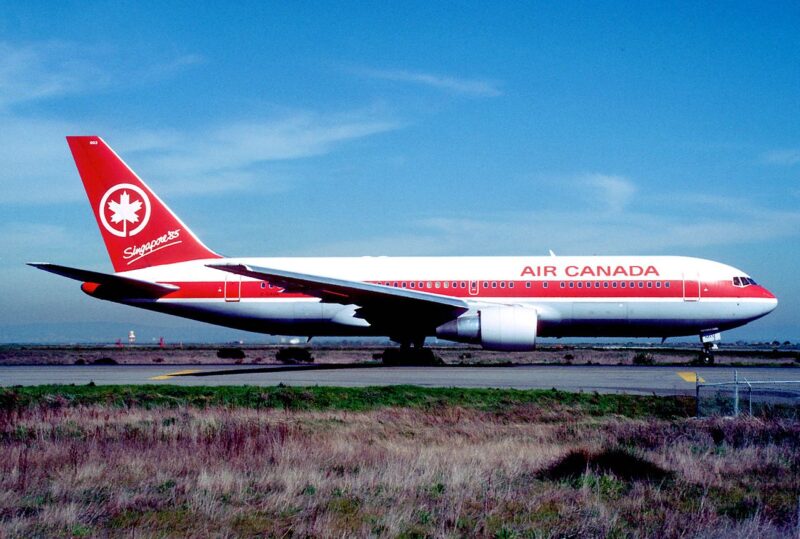
To comprehend the sequence of events leading to the emergency landing, we must go back to the previous day when the aircraft was in Edmonton. During a routine service check, the fuel gauges on the Boeing 767 were found to be blank, indicating a problem with the fuel quantity indicators for the centre auxiliary tank and the left and right main tanks, located in the wings.
Conrad Yaremko, a Certified Aircraft Technician, discovered that disabling channel 2 of the digital fuel gauge processor could provide fuel indications on the cockpit gauges. He tagged the circuit breaker as “inoperative” and noted the issue in the logbook. The aircraft was dispatched under the provisions of the Minimum Equipment List (MEL), which allowed it to operate with one channel of the fuel gauge processor inoperative.
The next morning, the aircraft flew to Ottawa and Montreal without any issues. Since the fuel-quantity indicator sensor (FQIS) was operating on a single channel, the crew on these flights took a dripstick reading to verify the fuel quantity, which matched the FQIS reading.
At Montreal, Captain Pearson and F/O Quintal took over Flight 143 to Ottawa and Edmonton. During the handover, Captain Pearson was informed about the FQIS issue. He then decided to take on enough fuel to fly to Edmonton without refueling in Ottawa where maintenance staff were waiting to install a working FQIS that they had borrowed from another airline.
Meanwhile, an avionics technician entered the cockpit and read the logbook. While waiting for the fuel truck, the technician performed an FQIS self-test, leaving the defective channel enabled after it failed amid distraction by the arrival of the fuel truck.
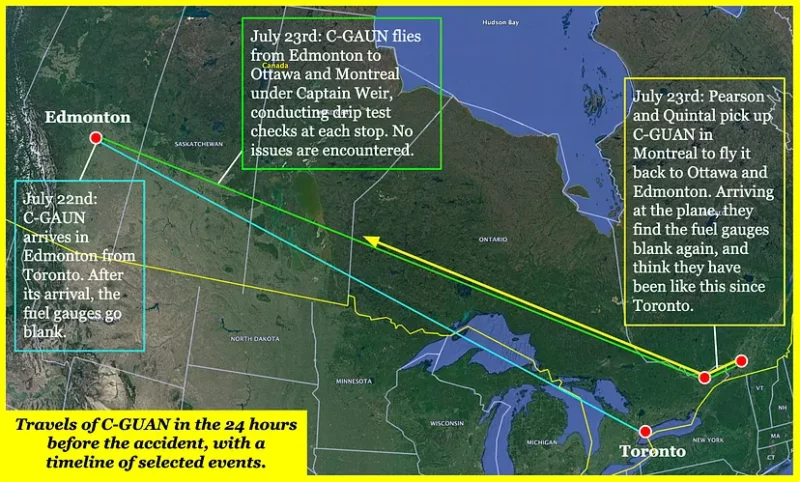
Captain Pearson entered the cockpit to find the FQIS blank, as expected. After taking a dripstick measurement, Pearson miscalculated the fuel quantity using the density figure for jet fuel in pounds/liter instead of kilograms/liter, as required for the metric system used in the Boeing 767 fleet.
As the FQIS was not operational, the captain manually entered the reading into the flight management computer, which tracked fuel in kilograms. After consulting the MEL, Flight AC143 took off from Montreal with 61 passengers and 8 crew members on board. However, little did anyone know that unforeseen circumstances would soon plunge the flight into a life-threatening situation.
The aircraft flew to Ottawa, where another dripstick measurement was taken using the incorrect density in pounds/liter. Believing they had enough fuel to reach Edmonton, no additional fuel was loaded in Ottawa.
Both in Montreal and later in Ottawa, the crew and maintenance personnel miscalculated the fuel load, using an incorrect conversion factor of 1.77 (pounds/liter) instead of the correct conversion factor of around 0.8 (kilograms/liter) for the all-metric Boeing 767 aircraft.
Running out of Fuel & Diversion
At an altitude of 41,000 feet, about midway through the flight, a series of technical issues began to unfold. The warning lights indicated low fuel pressure in the left fuel pump. Shortly after, the right main tank also experienced fuel pressure loss, and both engines failed. The aircraft began descending rapidly.
As the situation escalated, they were now gliding at an altitude normally reserved for commercial flights. The aircraft was at 35,000 feet, 65 miles from Winnipeg and 45 miles from Gimli at that time.
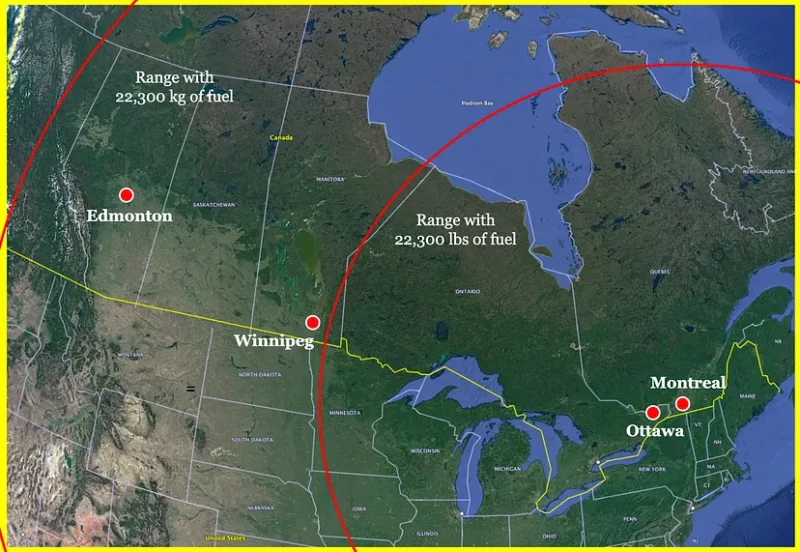
Captain Pearson, drawing upon his experience as a glider pilot, skillfully calculated the aircraft’s optimal glide speed to maximize their chances of reaching a suitable landing site. The crew had initially decided to navigate the aircraft toward Winnipeg. However, realizing that they couldn’t reach Winnipeg, Captain Pearson, with consultation from Air Traffic Control, decided to redirect the aircraft toward a former Royal Canadian Air Force base in Gimli, which was 12 miles away.
The situation was dire. Without power, all electronic gauges in the cockpit went blank, leaving only basic stand-by instruments for navigation. With precision, Captain Pearson glided the aircraft toward Gimli’s runway, aiming for a safe landing.
Landing at Gimli
Unbeknownst to the flight crew, part of the former Air Force base had been converted into a racetrack, Gimli Motorsports Park. As the aircraft descended towards the decommissioned runway, it became apparent that the landing was going to be anything but routine.
As the aircraft approached the runway, the pilots realized it was coming in too high and fast. As a result, the Captain executed a side-slip manoeuvre to lose height and speed, successfully touching down within 800 feet of the threshold. But F/O Quintal’s attempt to lower and lock the nose wheel manually failed, posing a serious challenge.
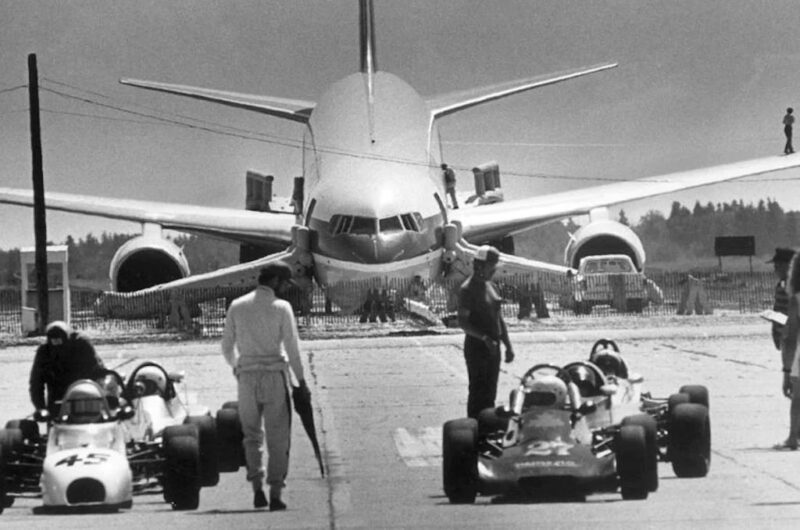
However, fate had an element of fortune in store. The presence of a guardrail along the runway and the failed nose gear inadvertently played a role in averting a disaster. As the aircraft skidded to a stop, the unlocked nose gear collapsed, causing the nose to slam, bounce, and scrape along the ground. This added friction helped slow the aircraft, preventing it from careening into the crowds surrounding the runway, including spectators at the motorsports event.
Flight 143 came to a final stop on the ground 17 minutes after running out of fuel over Red Lake, Ontario, about halfway to its destination.
Aircraft Damage & Injuries
Despite the high-stakes emergency landing, the aircraft remained remarkably intact, with only minor damage. The quick-thinking and decisive actions of Captain Pearson and First Officer Quintal had averted a potentially catastrophic outcome.
As the aircraft’s nose had collapsed onto the ground, its tail was elevated, leading to some minor injuries when passengers exited via the rear slides.
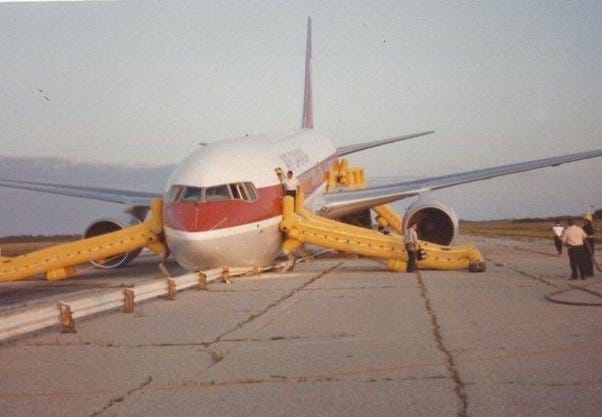
Thankfully, there were no serious injuries among the 69 occupants on board or the people on the ground.
Investigation
Following the incident, a thorough investigation was launched by the Aviation Safety Board of Canada to understand the chain of events that led to fuel depletion and technical failures. Both fuel tanks were found empty.
The investigation pointed out several deficiencies within Air Canada’s corporate structure and equipment management. It also revealed a series of errors, miscommunications, and misunderstandings, leading to the incorrect measurement of fuel. Despite this, the flight and cabin crews were highly praised for their professionalism and skill in handling the emergency situation.
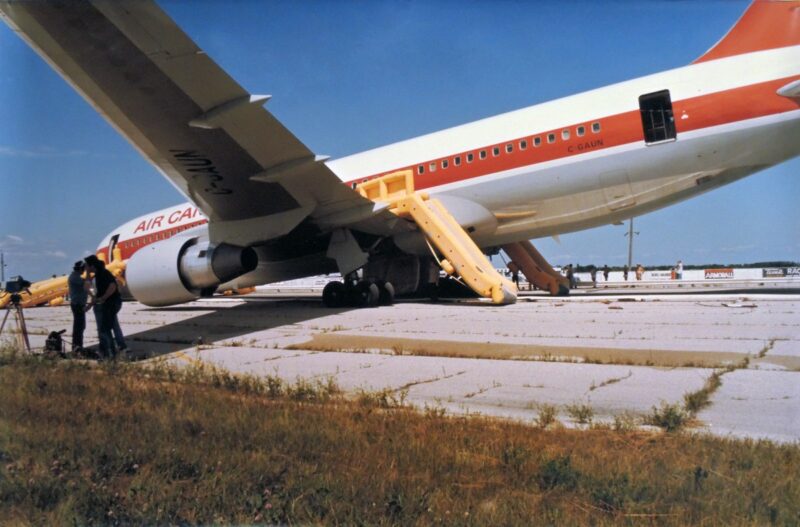
One of the key issues identified in the investigation was the unreliable Fuel-Quantity Indication System (FQIS) on the Boeing 767. Inconsistencies in the operation of the FQIS were also observed in other 767s. As a result, Boeing had issued a service bulletin for routine checks of the system, but the problem persisted.
When the FQIS on Flight 143 failed, a maintenance engineer attempted a temporary fix by disabling one channel. However, in a series of misunderstandings and miscommunications, this temporary fix was left in place, leading to a complete failure of the FQIS during the flight.
Miscalculation of Fuel
Another critical factor contributing to the incident was a miscalculation during fueling. With the FQIS not operational, Captain Pearson decided to take on enough fuel to reach Edmonton without refueling in Ottawa. However, a series of misunderstandings about the fuel load and incorrect conversion metrics led to the aircraft being fueled with less than half the required amount of fuel.
Since the FQIS was malfunctioning, Captain Pearson decided to load enough fuel in Montreal to reach Edmonton without refueling in Ottawa. The flight plan indicated a requirement of 22,300 kilograms (49,200 lb) of fuel for the journey. A dripstick measurement revealed that 7,682 liters (1,690 imperial gallons; 2,029 US gallons) of fuel were already in the tanks. Captain Pearson needed to convert this volume to kilograms, subtract it from the total required fuel, and then convert the result back to liters. The correct calculation, using the metric density of 0.803 kg/L, should have been:
- Fuel already on board: 7,682 L × 0.803 kg/L = 6,169 kg
- Additional fuel needed: 22,300 kg – 6,169 kg = 16,131 kg
- The volume of additional fuel needed: 16,131 kg ÷ 0.803 kg/L = 20,088 L
However, the confusion arising from the ongoing transition from Imperial to metric units in Canada’s aviation sector played a significant role. The fueler reported the density of jet fuel as 1.77 lb/L, in Imperial units. Captain Pearson and First Officer Quintal, without converting to metric units, performed their calculations using this Imperial density:
- Fuel already on board (incorrectly calculated as kilograms): 7,682 L × 1.77 lb/L = 13,597 lb
- Incorrect additional fuel needed: 22,300 kg – 13,597 kg = 8,703 kg
- The incorrect volume of additional fuel needed (interpreted as liters): 8,703 kg ÷ 1.77 lb/L = 4,917 L·kg/lb
As a result, instead of loading the required 20,088 liters of additional fuel, they mistakenly loaded only 4,917 liters. This miscalculation led to a total fuel load of 22,300 lb (10,100 kg) instead of the necessary 49,170 lb (22,300 kg), leaving the aircraft with less than half the fuel required for the journey.
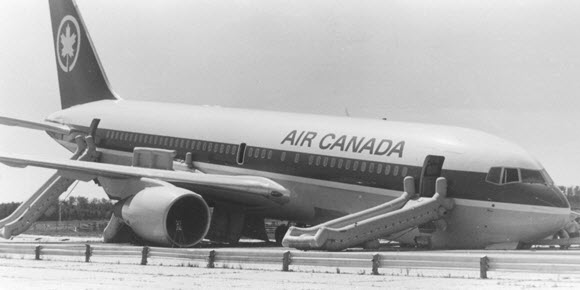
The investigation also revealed that Air Canada lacked clear responsibility assignment for calculating fuel loads, as older aircraft with a three-person crew had a flight engineer who supervised fueling. The lack of clear guidelines and oversight contributed to the errors made during fueling.
Aftermath
In the aftermath of the incident, the Aviation Safety Board recommended significant changes to Air Canada’s procedures and training. Air Canada was urged to assign clear responsibility for calculating fuel loads, maintaining an adequate inventory of spare parts, providing thorough training on the metric system, and improving procedures for cross-checking fuel quantities.
Captain Pearson and First Officer Quintal faced consequences for their roles in the incident. Pearson was demoted for six months, and Quintal was suspended for two weeks. Additionally, three maintenance workers were also suspended. Despite the initial consequences, Pearson and Quintal were later awarded the first-ever Fédération Aéronautique Internationale Diploma for Outstanding Airmanship for their remarkable handling of the emergency situation.
Following the incident, Flight 143, the Gimli Glider, continued its service with Air Canada until its final revenue flight on January 1, 2008. On January 24, 2008, it took its last journey to Tucson International Airport before being retired in the Mojave Desert, California.
In commemoration of the 25th anniversary of the incident, a parade was held in Gimli, Manitoba, celebrating the heroic pilots, and a mural was dedicated to mark the historic landing.
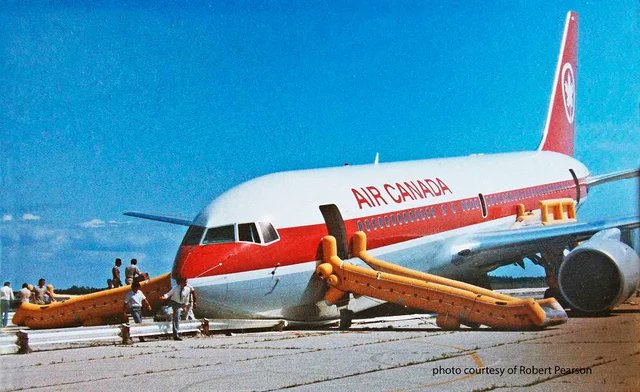
As a testament to its unique legacy, the Gimli Glider became the subject of television movies and documentaries, further immortalizing the unique tale of a flight that ran out of fuel but glided to a safe landing, forever earning its place in aviation folklore. A permanent museum exhibit in Gimli continues to honour the event, offering visitors a chance to learn about the remarkable story and the pilots who skillfully guided the Gimli Glider to its place in aviation history.
Sources: Final Report, Wikimedia



